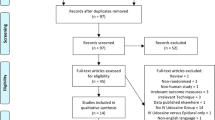Abstract
Purpose of Review
The purpose of this review is to provide a summary of the perioperative studies that have examined transdermal lidocaine (lidocaine patch) as an analgesic and put the evidence in context of the likely overall benefit of transdermal lidocaine in the perioperative period.
Recent Findings
Several randomized controlled trials have been published in the past 4 years that concluded transdermal lidocaine can reduce acute pain associated with laparoscopic trocar or cannula insertion.
Summary
Transdermal lidocaine may reduce short-term pain after surgery in selected surgery types and has a low risk of toxicity but its overall clinical utility in the perioperative setting is questionable. Transdermal lidocaine does not consistently reduce opioid consumption after surgery and has not been shown to improve patient function.

Similar content being viewed by others
References
Papers of particular interest, published recently, have been highlighted as: • Of importance •• Of major importance
Shah A, Hayes CJ, Martin BC. Characteristics of initial prescription episodes and likelihood of long-term opioid use—United States, 2006-2015. MMWR Morb Mortal Wkly Rep. 2017;66(10):265–9.
Bremer G, Ekmanner S, et al. Xylocaine; a new local anaesthetic. Br Dent J. 1948;85(12):278–81.
• Sommer C, Cruccu G. Topical treatment of peripheral neuropathic pain: applying the evidence. J Pain Symptom Manage. 2017;53(3):614–29. Provides good summary of available modalities used as topical treatments.
Liu SS, Lin Y. Local Anesthetics. In: Barash PG, Cullen BF, Stoelting RK, Cahalan MK, Stock MC, editors. clinical anesthesia. 6th ed. Philadelphia: Lippincott, Williams, and Wilkins; 2009. p. 531–48.
•• Davies PS, Galer BS. Review of lidocaine patch 5% studies in the treatment of postherpetic neuralgia. Drugs. 2004;64(9):937–47. Provides important details about how transdermal lidocaine works in neuropathic pain.
Moher D, Liberati A, Tetzlaff J, Altman DG, Group P. Preferred reporting items for systematic reviews and meta-analyses: the PRISMA statement. PLoS Med. 2009;6(7):e1000097.
Lau LL, Li CY, Lee A, Chan SK. The use of 5% lidocaine medicated plaster for acute postoperative pain after gynecological surgery: a pilot randomized controlled feasibility trial. Medicine (Baltimore). 2018;97(39):e12582.
Lee W, Hahn K, Hur J, Kim Y. Effect of topical lidocaine patch on postoperative pain management in laparoscopic appendectomy: a randomized, double-blind, prospective study. J Laparoendosc Adv Surg Tech A. 2018;28(9):1061–7.
Hong JM, Lee HJ, Cho AR, et al. Pretreatment with 5% lidocaine patch reduces cannula-induced and propofol-induced pain: a randomized, double-blind, placebo-controlled study. Korean J Anesthesiol. 2016;69(5):468–73.
• Vrooman B, Kapural L, Sarwar S, et al. Lidocaine 5% patch for treatment of acute pain after robotic cardiac surgery and prevention of persistent incisional pain: a randomized, placebo-controlled, double-blind trial. Pain Med. 2015;16(8):1610–21. This study was well designed and executed.
Elhafz AA, Elgebaly AS, Bassuoni AS, El Dabaa AA. Is lidocaine patch as effective as intravenous lidocaine in pain and illus reduction after laparoscopic colorectal surgery? A randomized clinical trial. Anesth Essays Res. 2012;6(2):140–6.
Kwon YS, Kim JB, Jung HJ, et al. Treatment for postoperative wound pain in gynecologic laparoscopic surgery: topical lidocaine patches. J Laparoendosc Adv Surg Tech A. 2012;22(7):668–73.
Habib AS, Polascik TJ, Weizer AZ, et al. Lidocaine patch for postoperative analgesia after radical retropubic prostatectomy. Anesth Analg. 2009;108(6):1950–3.
Atkins D, Best D, Briss PA, et al. Grading quality of evidence and strength of recommendations. BMJ. 2004;328(7454):1490.
Higgins JP, Altman DG, Gotzsche PC, et al. The Cochrane collaboration's tool for assessing risk of bias in randomised trials. BMJ. 2011;343:d5928.
Bai Y, Miller T, Tan M, Law LS, Gan TJ. Lidocaine patch for acute pain management: a meta-analysis of prospective controlled trials. Curr Med Res Opin. 2015;31(3):575–81.
Mazurenko O, Collum T, Ferdinand A, Menachemi N. Predictors of hospital patient satisfaction as measured by HCAHPS: a systematic review. J Healthc Manag. 2017;62(4):272–83.
Stanowski AC, Simpson K, White A. Pay for performance: are hospitals becoming more efficient in improving their patient experience? J Healthc Manag. 2015;60(4):268–85.
Funding
Departmental funds only.
Author information
Authors and Affiliations
Corresponding author
Ethics declarations
Conflict of Interest
The authors declare no conflicts of interest relevant to this manuscript.
Human and Animal Rights and Informed Consent
This article does not contain any studies with human or animal subjects performed by any of the authors.
Additional information
Publisher’s Note
Springer Nature remains neutral with regard to jurisdictional claims in published maps and institutional affiliations.
This article is part of the Topical Collection on Other Pain
Electronic supplementary material
ESM 1
(PDF 630 kb)
Rights and permissions
About this article
Cite this article
Smoker, J., Cohen, A., Rasouli, M.R. et al. Transdermal Lidocaine for Perioperative Pain: a Systematic Review of the Literature. Curr Pain Headache Rep 23, 89 (2019). https://doi.org/10.1007/s11916-019-0830-9
Published:
DOI: https://doi.org/10.1007/s11916-019-0830-9




